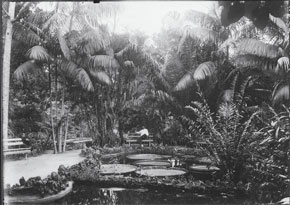 Files of Guilherme de La Penha / MPEG / MCTI
Files of Guilherme de La Penha / MPEG / MCTILake with vitoria-regia water lilies and possibly manatees: shaped like Russia’s Black SeaFiles of Guilherme de La Penha / MPEG / MCTI
Where could one find a museum with a park filled with native plants and wild animals in cages and which is visited by nearly the same number of people as the population of the city it is located in? The answer is: the city of Belem, in the late nineteenth and early twentieth centuries. More specifically, in 1896, the Zoo and Botanical Garden of the Goeldi Museum were visited by 48 thousand people, when the population of the city totalled approximately 50 thousand people. The capital of the state of Pará was enchanted with Brazil’s first zoo, which opened in 1895, alongside the museum created by Swiss zoologist Emílio Goeldi. This first zoo did not house elephants, giraffes, or rhinoceros, in the manner of European zoos. Here, the visitors enjoyed looking at native animals of the Amazon Region, such as tapirs, alligators, manatees, jaguars, and egrets, as had originally been planned by Goeldi.
The building of a zoo had already been in the plans of Para State Governor Lauro Sodré when he hired Goeldi in 1894 to run the institution. The Museu Paraense Emílio Goeldi (MPEG) museum had been founded in 1866 and had to be re-organized. At the time, the zoologist and his family were living in the city of Rio de Janeiro. Goeldi had worked at the National Museum for a few years and had close contact with scientists from abroad. “In Belem, he realized it was useless to compete with cosmopolitan museums and decided to create a regionalized institution, specialized in the Amazon Region. In addition, this was a way of ensuring that the institution would be acknowledged by the international scientific community,” says Nelson Sanjad, a researcher of the history of science at the Goeldi Museum and editor of the Boletim do MPEG, Ciências Humanas newsletter, whose January-April 2012 issue has an article on the Zoo and Botanical Gardens Park.
With the support of the state government, the Swiss scientist concentrated his efforts on work that lasted for eight years. The work was necessary to transform the museum into a center of research on the region’s flora and fauna – the park was one of the results. Goeldi designed the enclosures for the animals with the help of two people responsible for the management of the zoo and the botanical gardens. First, German zoologist Hermann Meerwarth, who was followed by Swiss zoologist Gottfried Hagmann.
 Files of Guilherme de La Penha / MPEG / MCTI
Files of Guilherme de La Penha / MPEG / MCTIA special family day was created in 1902 for appropriately dressed people and families: segregationFiles of Guilherme de La Penha / MPEG / MCTI
The research and the collection of regional animals did not keep the museum from acquiring European characteristics. “The plants and the animals were from the region. But the design, the architectural elements, nurseries, and other features resembled European landscapes and monuments,” says Sanjad. “Although this might sound like a paradox, this was in line with the mentality of the elite at that time.” The museum’s homes and laboratories, for example, were built in the manner of Swiss chalets. The lake for water birds was shaped like Italy’s Lake Maggiore. The wire cover was manufactured in Paris. The lake for the vitoria-regia water lilies was shaped like southern Russia’s Black Sea.
The carefully built zoo and botanical garden – entrance to which was free of charge – became the main place of recreation for the urban population and for immigrants who had long lost most contact with animals. Baby jaguars, nest-building birds, a swimming fish with lungs (a species that was difficult to maintain in captivity) and the flowering of the water lilies – for the first time cultivated in a public environment in the Amazon Region – were attractions that enchanted the visitors.
The huge success led to at least one problem. The city’s economic elite began to complain about the bad manners of the masses that visited the museum on Sundays and holidays. Goeldi reacted to the pressure by creating a “family day” in 1902. The park was opened one more weekday – more specifically, on Tuesdays, only for families and for visitors who were appropriately dressed. “In practical terms, visitors to the park were segregated according to social class,” says Sanjad.
The park remained the city’s main attraction until the 1940s, when other zoos were opened in other parts of the country. Belem’s current population totals two million people. The Zoo and Botanical Garden are visited by 200 thousand to 250 thousand people a year. This number is not as impressive as it was 117 years ago; however, the number of annual visitors corresponds to 10% of the city’s population, which is in line with international standards.
Republish
